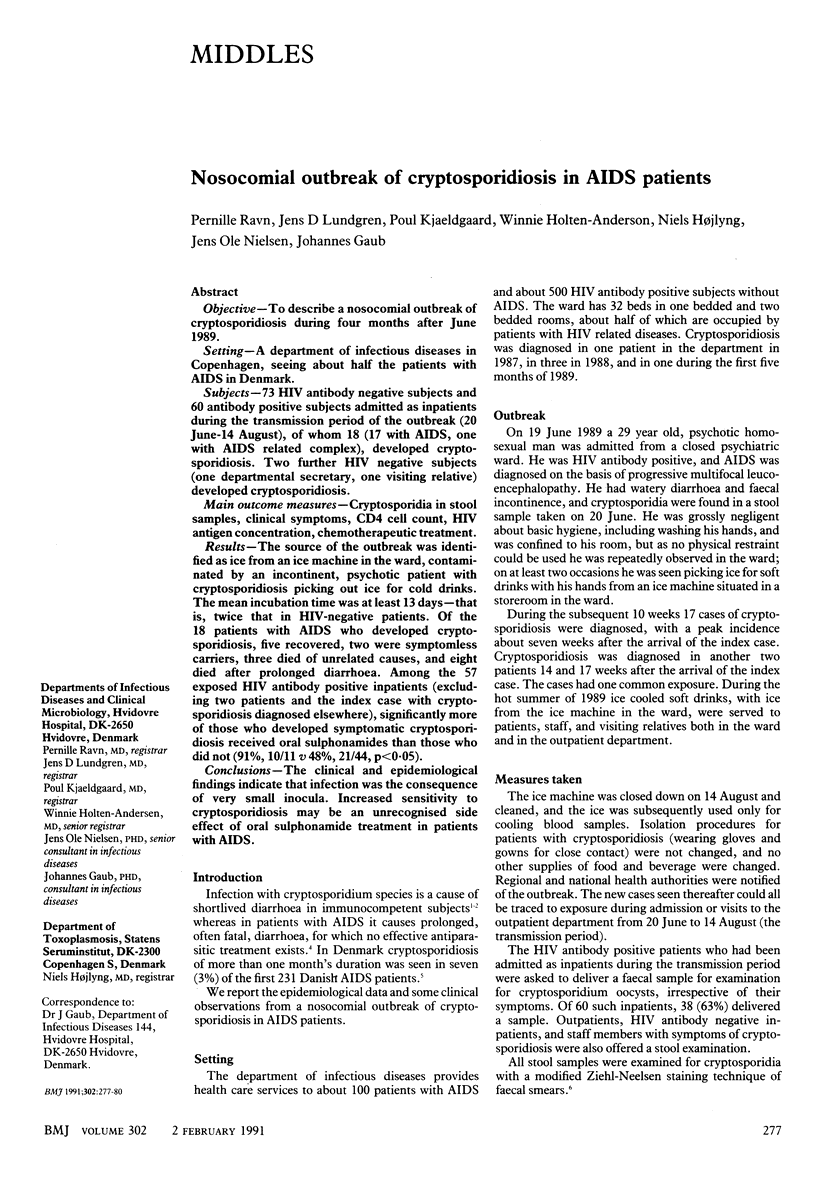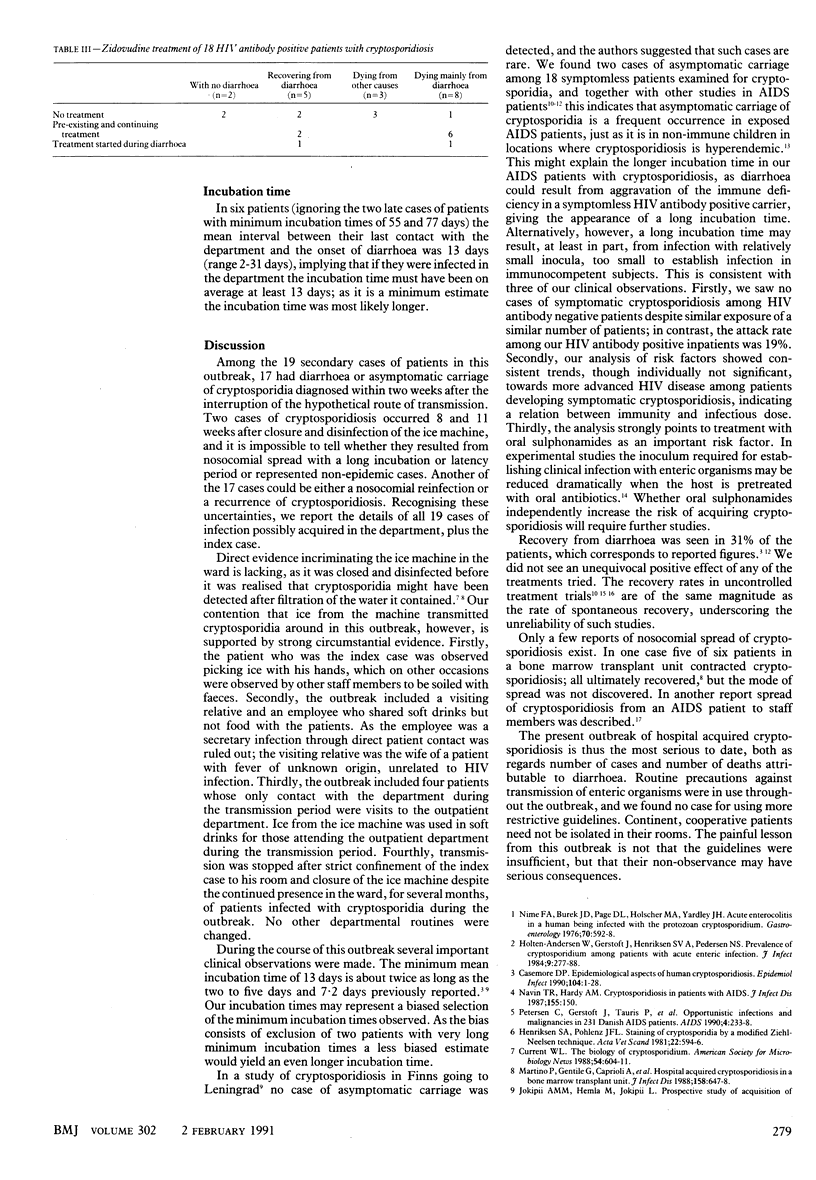Abstract
OBJECTIVE--To describe a nosocomial outbreak of cryptosporidiosis during four months after June 1989. SETTING--A department of infectious diseases in Copenhagen, seeing about half the patients with AIDS in Denmark. SUBJECTS--73 HIV antibody negative subjects and 60 antibody positive subjects admitted as inpatients during the transmission period of the outbreak (20 June-14 August), of whom 18 (17 with AIDS, one with AIDS related complex), developed cryptosporidiosis. Two further HIV negative subjects (one departmental secretary, one visiting relative) developed cryptosporidiosis. MAIN OUTCOME MEASURES--Cryptosporidia in stool samples, clinical symptoms, CD4 cell count, HIV antigen concentration, chemotherapeutic treatment. RESULTS--The source of the outbreak was identified as ice from an ice machine in the ward, contaminated by an incontinent, psychotic patient with cryptosporidiosis picking out ice for cold drinks. The mean incubation time was at least 13 days-that is, twice that in HIV-negative patients. Of the 18 patients with AIDS who developed cryptosporidiosis, five recovered, two were symptomless carriers, three died of unrelated causes, and eight died after prolonged diarrhoea. Among the 57 exposed HIV antibody positive inpatients (excluding two patients and the index case with cryptosporidiosis diagnosed elsewhere), significantly more of those who developed symptomatic cryptosporidiosis received oral sulphonamides than those who did not (91%, 10/11 v 48%, 21/44, p less than 0.05). CONCLUSIONS--The clinical and epidemiological findings indicate that infection was the consequence of very small inocula. Increased sensitivity to cryptosporidiosis may be an unrecognised side effect of oral sulphonamide treatment in patients with AIDS.
Full text
PDF



Selected References
These references are in PubMed. This may not be the complete list of references from this article.
- Casemore D. P. Epidemiological aspects of human cryptosporidiosis. Epidemiol Infect. 1990 Feb;104(1):1–28. doi: 10.1017/s0950268800054480. [DOI] [PMC free article] [PubMed] [Google Scholar]
- Connolly G. M., Dryden M. S., Shanson D. C., Gazzard B. G. Cryptosporidial diarrhoea in AIDS and its treatment. Gut. 1988 May;29(5):593–597. doi: 10.1136/gut.29.5.593. [DOI] [PMC free article] [PubMed] [Google Scholar]
- Henriksen S. A., Pohlenz J. F. Staining of cryptosporidia by a modified Ziehl-Neelsen technique. Acta Vet Scand. 1981;22(3-4):594–596. doi: 10.1186/BF03548684. [DOI] [PMC free article] [PubMed] [Google Scholar]
- Holten-Andersen W., Gerstoft J., Henriksen S. A., Pedersen N. S. Prevalence of Cryptosporidium among patients with acute enteric infection. J Infect. 1984 Nov;9(3):277–282. doi: 10.1016/s0163-4453(84)90618-2. [DOI] [PubMed] [Google Scholar]
- Hornick R. B., Greisman S. E., Woodward T. E., DuPont H. L., Dawkins A. T., Snyder M. J. Typhoid fever: pathogenesis and immunologic control. 2. N Engl J Med. 1970 Oct 1;283(14):739–746. doi: 10.1056/NEJM197010012831406. [DOI] [PubMed] [Google Scholar]
- Højlyng N., Mølbak K., Jepsen S. Cryptosporidium spp., a frequent cause of diarrhea in Liberian children. J Clin Microbiol. 1986 Jun;23(6):1109–1113. doi: 10.1128/jcm.23.6.1109-1113.1986. [DOI] [PMC free article] [PubMed] [Google Scholar]
- Janoff E. N., Limas C., Gebhard R. L., Penley K. A. Cryptosporidial carriage without symptoms in the acquired immunodeficiency syndrome (AIDS) Ann Intern Med. 1990 Jan 1;112(1):75–76. doi: 10.7326/0003-4819-112-1-75. [DOI] [PubMed] [Google Scholar]
- Jokipii A. M., Hemilä M., Jokipii L. Prospective study of acquisition of Cryptosporidium, Giardia lamblia, and gastrointestinal illness. Lancet. 1985 Aug 31;2(8453):487–489. doi: 10.1016/s0140-6736(85)90412-x. [DOI] [PubMed] [Google Scholar]
- Koch K. L., Phillips D. J., Aber R. C., Current W. L. Cryptosporidiosis in hospital personnel. Evidence for person-to-person transmission. Ann Intern Med. 1985 May;102(5):593–596. doi: 10.7326/0003-4819-102-5-593. [DOI] [PubMed] [Google Scholar]
- Martino P., Gentile G., Caprioli A., Baldassarri L., Donelli G., Arcese W., Fenu S., Micozzi A., Venditti M., Mandelli F. Hospital-acquired cryptosporidiosis in a bone marrow transplantation unit. J Infect Dis. 1988 Sep;158(3):647–648. doi: 10.1093/infdis/158.3.647. [DOI] [PubMed] [Google Scholar]
- Navin T. R., Hardy A. M. Cryptosporidiosis in patients with AIDS. J Infect Dis. 1987 Jan;155(1):150–150. doi: 10.1093/infdis/155.1.150. [DOI] [PubMed] [Google Scholar]
- Nime F. A., Burek J. D., Page D. L., Holscher M. A., Yardley J. H. Acute enterocolitis in a human being infected with the protozoan Cryptosporidium. Gastroenterology. 1976 Apr;70(4):592–598. [PubMed] [Google Scholar]
- Pedersen C., Gerstoft J., Tauris P., Lundgren J. D., Gøtzsche P. C., Buhl M., Salim Y., Schmidt K. Opportunistic infections and malignancies in 231 Danish AIDS patients. AIDS. 1990 Mar;4(3):233–238. doi: 10.1097/00002030-199003000-00009. [DOI] [PubMed] [Google Scholar]
- Rolston K. V., Fainstein V., Bodey G. P. Intestinal crytosporidiosis treated with eflornithine: a prospective study among patients with AIDS. J Acquir Immune Defic Syndr. 1989;2(5):426–430. [PubMed] [Google Scholar]
- Ungar B. L., Ward D. J., Fayer R., Quinn C. A. Cessation of Cryptosporidium-associated diarrhea in an acquired immunodeficiency syndrome patient after treatment with hyperimmune bovine colostrum. Gastroenterology. 1990 Feb;98(2):486–489. doi: 10.1016/0016-5085(90)90842-o. [DOI] [PubMed] [Google Scholar]
- Zar F., Geiseler P. J., Brown V. A. Asymptomatic carriage of cryptosporidium in the stool of a patient with acquired immunodeficiency syndrome. J Infect Dis. 1985 Jan;151(1):195–195. doi: 10.1093/infdis/151.1.195. [DOI] [PubMed] [Google Scholar]


